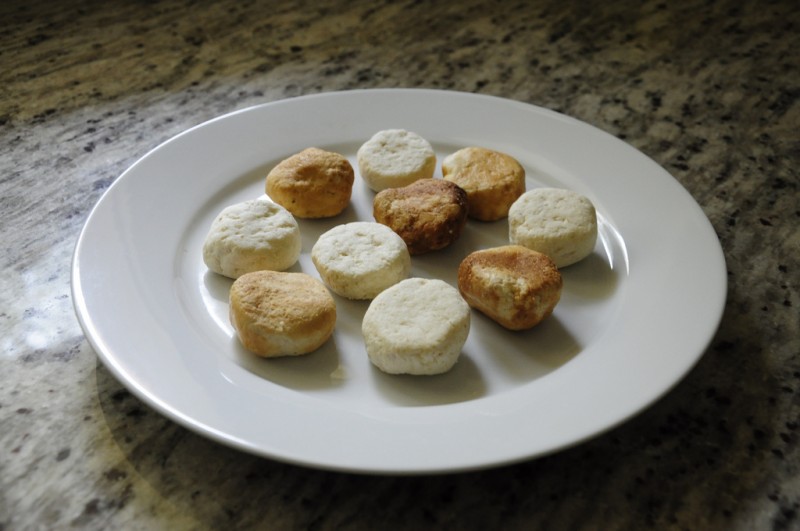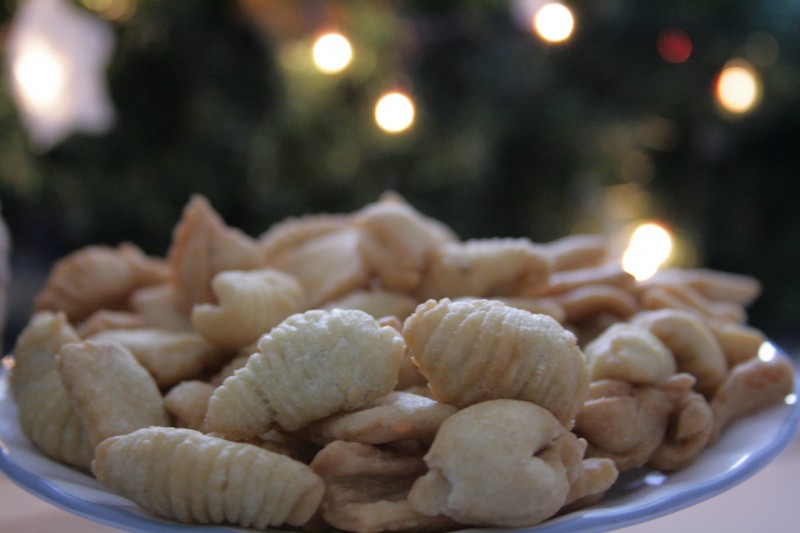The Portuguese established a colony in India at the beginning of the 16th century. Portuguese India was ruled first from Cochin, and then Goa. Over the next four centuries, Portuguese control spread to various parts of India, mostly along the west coast of the country, but also in the northeast in Bengal.
During this time, the Portuguese left their mark on certain Indian cuisines in two ways: by introducing new ingredients to India – including spices that are seen as an essential part of Indian food today – and by introducing Portuguese dishes that then were adapted to Indian culinary techniques and tastes.
The strongest Portuguese influence was of course in Goa, which Portugal ruled until 1961. In particular, Goan Catholic cuisine has a distinct Portuguese flavour. Blogger Hilda Mascarenhas describes the famous Goan dish pork vindaloo:
The name “Vindaloo” is derived from the Portuguese dish “Carne de Vinha d’Alhos” which is a dish of meat, usually pork, with wine and garlic. The Portuguese dish was modified by the substitution of vinegar (usually palm vinegar) for the red wine and the addition of red Kashmiri chillies with spices, to evolve into Vindaloo. The alternative terms are Vindalho or Vindallo. Traditional Goan Pork Vindaloo is intensely flavored with fragrant spices and does not include potatoes. No celebration and festive occasion is complete without the Goan Pork Vindaloo. It is enjoyed with the most popular and loved accompaniment, Goan sannas, which are prepared with toddy! This speciality is served with pride in every Goan home at Christmas, New Year and Easter.
Gavin Harvey adds:
Vindaloo started as a vinegar and garlic based stew made with pork or other meat but when introduced to India it got revamped with various spices and chillies. Potatoes were also added to the dish and “alhos” became “aloo” (Hindi word for “potatoes”) – so soon people assumed potatoes were a necessary ingredient of this dish.
Further down the coast from Goa is the city of Mangalore, and Mangalorean Catholic cuisine has many similarities with Goan Catholic cuisine. A pork dish common to both is sorpotel (or sarapatel), originally from the Alentejo region of Portugal. At the Goan Recipes blog, Glenn writes:
The word ‘sarapatel’ literally means confusion, probably referring to the mish-mash of ingredients of pork heart, liver and even pork blood!
Moving to the other side of India, some Portuguese influence can be seen in Bengali cuisine as well. Rangan Datta gives us the history of a special kind of cheese:
Originating from the erstwhile Portuguese settlement of Bandel (about 50 km north of Calcutta), Bandel Cheese is perhaps one of the last traces of Portuguese cuisine in Bengal. The Portuguese influence in Bengal dates back to the late 16th century. Almost a century after Vasco da Gama reached the West Coast of India the Portuguese started making their inroads into Bengal. […] It was the probably the Portuguese who introduced the art of cheese making in Bengal and in spite of all odds the technique has survived over centuries. The Bandel Cheese introduced by the Portuguese was probably made by the Mogh (Burmese) cooks under Portuguese supervision. […] This variety of unripened cheese is made from cows milk and comes in two versions plain and smoked. First the the curd is extracted from the cows milk by using lemon juice. The cheese is then shaped and drained in perforated pots. The plain variety is of milk-white colour and comes in disc shapes of about an inch diameter and quarter of inch thickness. The smoked variety comes in the same shape and size but has a crispy brownish crust covering the soft milk-white interior.
Zoe Perrett notes:
The Portuguese influence on Bengal was not pure. Having gone to Goa first, many of the new introductions were delivered with a distinct Western Indian accent, or, indeed, were dishes the Portuguese purloined directly from that small state. The Portuguese also proffered Bengal bounty from travels further afield; fruity beauties like pineapple, papaya, guava, and the lychees from the Orient. Where Goa absorbed the influences, blending Portuguese techniques and dishes with local spices, in Bengal, many of the Portuguese-provided ingredients have retained their own clear identity. Mogh cooks soon mastered Western baking methods; displayed today in Calcutta’s prolific puffs and pastries, and perhaps also in the use of white flour for ‘luchis’ (a Bengali bread).
The Portuguese left a legacy of sweet as well as savoury dishes in India. Kulkuls, or kidyo, are a type of sweet eaten by Goan and Mangalorean Catholics at Christmas. Aparna Balasubramaniam describes them:
Kulkuls are made by deep-frying inch long bits of sweet dough moulded/shaped into small curls (like butter curls) which are often also coated with a sugar glaze which dries out. The kulkuls tend to resemble small worms, hence the name “Kidyo” in Konkani, the language spoken in Goa. If you do not to think of them as “worms” you can think of them as shell-shaped. I like to think that the name Kulkul/Kalkal comes from the rattling sound of these little treats jostling one another when they’re shaken in sugar syrup or maybe in the tin in which they would be stored. Kulkuls are made during Christmas in Goa and are an important item in the Kuswar (a collection of Goan Christmas-time treats), and are distributed to neighbours. They’re also taken along to give away during “obligatory” visits to friends and family. […] Someone pointed out the Kulkuls are actually a variation of the Portuguese Filhoses Enroladas, which is a roll or curvy noodle-shaped Christmas-time sweet that is deep-fried and sugar-glazed. So it is possible that Kulkuls were brought to India by the Portuguese.










7 comments
All the above dishes are delicious.
http://www.fazlani.com/
Thanks for quoting me in this, Ayesha! It’s a subject close to my heart as I serve up the Goan food that my friend Nilanjani cooks at her London supperclub, Damn Good Curry.
Another friend (and legendary UK chef) Cyrus Todiwala is also just about to open a Goan Portuguese restaurant in London – a very exciting prospect with a pretty unique menu. I interviewed him about it here: http://culinaryadventuresofthespicescribe.wordpress.com/2014/02/23/interview_with_indian_chef_cyrus_todiwala_assado_portuguese_inspired_restaurant_london/
Duck fry, fish molly or moi lee, mutton chops, lamb curry, pork chops, pork barbecues, pork sandwiches, the famous Portuguese beef stew, beef roast and steak were introduced in Kerala by the Portuguese during their 150 year dominance in Kochi. These tasty dishes replaced the staple food of the locality — kappa and meen (tapioca and fish).and the rich showed great interest for Portuguese dishes. The Portuguese employed local people as cooks and taught them how to make Portuguese dishes.,
Silly question I suppose, but what happened to Portuguese cuisine in general (Portugal), as they very rarely use spices to spice up their food. Did they export it all and keep none for Portugal?
I want information about relation with Portugese cuisine and Recheado spice, used in fish dishes. This is portugese influence in indian goan dishes. anybody know about it ?